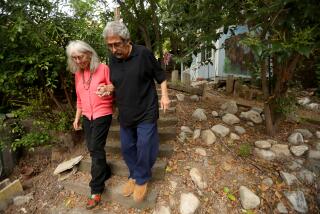A Crack in the Mirror
- Share via
All of her life Ilene Eddy has been able to look at her sister, Irene Peterson, and see a mirror image of herself.
The twins--as everyone calls them--have always dressed alike, worn their hair the same and done things together. Back on the farm in Iowa, where they grew up in a family of 10 children, it was said that if you stepped on one’s toes, the other one felt it.
Even today, the twins, both widowed, dress alike and live together in a Long Beach duplex.
But at 87, Ilene sees not only her mirror image when she looks at her white-haired identical twin; she also sees her future.
“For 19-year-olds we’re in good health,” Ilene jokes during a break in their monthly samba card game in a golf course clubhouse. Then, with a nod to Irene, she adds, “My health is a little better than hers.”
It’s about as close as Ilene gets to confirming what is clear to friends and relatives: She and her twin have Alzheimer’s disease.
More than 4 million Americans are afflicted with the progressive and irreversible disease that attacks the brain and results in impaired memory, thinking and behavior.
What causes Alzheimer’s disease remains a mystery. And for reasons that continue to perplex researchers, the disease progresses at different rates with each individual. Even twins with identical genes.
Irene showed signs of Alzheimer’s six years ago, when relatives discovered her having a conversation with her “twin” in a mirror. She is now in an advanced stage of the disease.
Ilene is in an early stage of Alzheimer’s; friends and relatives noticed she was having problems with short-term memory about two years ago.
Irene can no longer be left alone or hold a normal conversation; Ilene is able to do most things for herself but often repeats statements and doesn’t know her way home. A part-time health aide now helps out during the day.
It’s unknown how many identical twins have the disease, but, according to the Alzheimer’s Assn., an estimated 10% of the U.S. population over age 65--and nearly half of those over 85--are affected.
When an identical twin gets Alzheimer’s, there is about a 50% chance--regardless of age--that the other will also have or develop it.
Identical twins like Ilene and Irene are playing an important role in research attempting to solve the mystery of Alzheimer’s.
The sisters recently became part of an ongoing national study by Duke University of 65 pairs of identical twins of all ages, in which one or both have the disease.
The purpose of the study, part of the university’s 9-year-old research program on identical twins with Alzheimer’s, is to identify nongenetic causes for the disease, says Brenda Plassman, one of the investigators in Durham, N.C.
“Basically, the logic is that two members of any given identical twin pair have identical genes, but if one member gets AD and one does not--or if one member gets AD much earlier than the co-twin--those differences must be due to nongenetic factors” such as the environment, medications and lifestyle differences.
The emotional reaction of twin members watching the disease take over their mirror image varies, says Plassman.
“We often hear comments like, ‘I’m nowhere near as bad as my twin [mentally],’ and sometimes it is normal aging versus non-normal aging,” Plassman says.
Still, she says, “we’ll see a full range of emotional responses, from being a caretaker to keeping more distance because it’s really too painful to visit this person who you have lived with all your life and who’s just like you and who’s changing.”
As is often the case with Alzheimer’s, the realization that the twins were ill came slowly.
At a lunch after the funeral of the twins’ brother Conrad in early 1992, relatives noticed Irene take the money out of her purse, count it and put it away--then do the same thing again and again.
“We thought, ‘This is pretty unusual behavior,’ ” recalls Larry Lindgren, the twins’ nephew, who accompanied his aunts to the funeral in Sioux City, Iowa.
In the following months, as Lindgren and his wife, Janet, visited Ilene and Irene, they noticed that Irene had begun repeating things.
“She’d ask a question, and we’d give her an answer, and a little bit later she’d ask the question again,” recalls Lindgren, 71, of Camarillo.
Yet it wasn’t until the mirror incident that Lindgren knew “things were really serious.”
The Lindgrens and the twins were going out for Sunday dinner when Lindgren found Irene talking to herself in the bathroom mirror, trying to convince her “twin” that it was time to go.
It wouldn’t be the last time they would find Irene talking to a mirror.
“I felt really bad because here’s this lady who was 100% sharp all her life, and she’s going downhill,” says Lindgren. “I was really depressed, probably for at least six months. Then I finally figured out there’s nothing I can do, or that she can do, or her sister or the medical folks can do: This is the way it is; let’s accept it and try and make the best of it.”
Still, he says, “it’s almost like watching someone die. You remember how they used to be, and it’s really sad.”
Longtime friend Thera Boyer of Seal Beach had noticed a change in Irene during their regular bridge games.
“All of a sudden she started to bid real crazy,” Boyer recalls. Others may not have noticed anything unusual about Irene at the time, she says, “but to play bridge you really have to have your brains.”
Boyer noticed another change.
“She’ll lash out at her twin,” Boyer says. “She’ll swear at her. She never did that before--never!”
Lindgren says Ilene tries to correct her sister, telling her “‘Don’t do this,’ or ‘Do this,’ or whatever--and doesn’t want to accept the fact that Irene simply can’t do this any more.”
As Lindgren sees it, “Ilene knows Irene is mentally impaired, but she’s resisting the reality. Alzheimer’s is a bad word in her vocabulary. She absolutely knows that her own short-term memory is failing, and she recognizes that. But in her view that could just be old age and not necessarily Alzheimer’s.”
By all accounts, Irene was the stronger, more assertive of the two. But as her condition has worsened in relation to her sister’s, that has changed, say those close to them.
The role-reversal has taken a toll on Ilene. Worrying and fretting over her sister has caused Ilene to lose weight and, says one longtime friend, “she’s a walking nervous wreck.”
The emotional toll was evident at the recent samba card club game, but so was the one enduring hallmark of the twins’ relationship. Ilene and Irene are as close as ever.
“As close as 10 after 2,” quips fellow card-club member Boyer.
At one time, members filled four or five tables. Now they’re lucky to fill two. At 80, Boyer calls herself “the baby of the bunch.”
“Some have died; some have gotten ill,” she says, “but the twins go on and on.”
Irene makes it to the games but is no longer able to play. Ilene plays samba but has begun bidding as if she were playing bridge.
“It’s getting out of the house that’s more important than the cards,” Ilene says. “We’re fortunate. A lot of people younger than we are can’t feed themselves. We thank the Lord.”
Then she adds: “I’ve got my license and my car, but I tell you it doesn’t do me any good. I get three blocks from home, and I can’t find my house.”
Despite the truth of her statement, Ilene says the last line as though she were delivering the punch line of a joke. Friends say the twins always had good senses of humor.
Ilene notices that Irene is toying with her pastry.
“Here, Irene, are you through with it?” Ilene asks, like a mother to a young child. Then she shrugs: “Eat it if you want to.”
A few minutes later, Irene is poking at the sugar packets on the table.
“Here, just leave those!” Ilene snaps at her, then reaches over to pull down the top of her sister’s dress, which has bunched up from her constant tugging.
“Irene, put your dress down!” Ilene says, pulling her sister’s hand away from her dress. “Irene, don’t pull it that way. Just leave it!
The women are wearing the same blue-and-lavender print dresses.
“Mother always dressed us alike,” Ilene says. “We didn’t object to dressing alike. One time we bought separate dresses, but we gave them to our sister because we wouldn’t wear them.”
They always wore their hair the same way too. From the childish curls of the farm days to the perms of their later years, their hairstyles have been a part of the twins’ closeness.
But the last time they went to the beauty shop, Irene complained that the hairdresser pulled her hair and she refuses to return.
Now only Ilene’s hair is permed. And that bothers her.
“How,” she asks, “can we be twins when our hair isn’t the same?”
(BEGIN TEXT OF INFOBOX / INFOGRAPHIC)
THE SERIES
1 A CRACK IN THE MIRROR: Twins share so much--including a diagnosis of Alzheimer’s disease.
2 UNRAVELING THE PAST: Research looks for uncommon threads in a pair of intertwined lives.
3 GROWING UNCERTAINTIES: The only sure thing in the sisters’ future is an accelerating need for care.
* ON THE WEB: On the Los Angeles Times Web site.
ALZHEIMER’S FACTS
* Alzheimer’s is a progressive, degenerative disease that attacks the brain and results in impaired memory, thinking and behavior. It was first described by Dr. Alois Alzheimer, a German psychiatrist and neuropathologist, in 1906.
* Alzheimer’s is the most common form of dementia. It afflicts more than 4 million Americans.
* Symptoms can include gradual memory loss, decline in the ability to perform routine tasks, disorientation, difficulty in learning, loss of language skills, impairment of judgment, personality changes.
* Rate of progression varies. Although eight years is the average time from the onset of symptoms to death, it can range from three to 20 years.
* Tests may provide a diagnosis of possible or probable Alzheimer’s disease, but confirmation can only be obtained by examining brain tissue, which is usually done in an autopsy. Evaluation to establish diagnosis includes health history, physical exam, neurological and mental assessments.
* There is no cure for Alzheimer’s disease.
Source: Alzheimer’s Assn.
More to Read
Sign up for Essential California
The most important California stories and recommendations in your inbox every morning.
You may occasionally receive promotional content from the Los Angeles Times.













